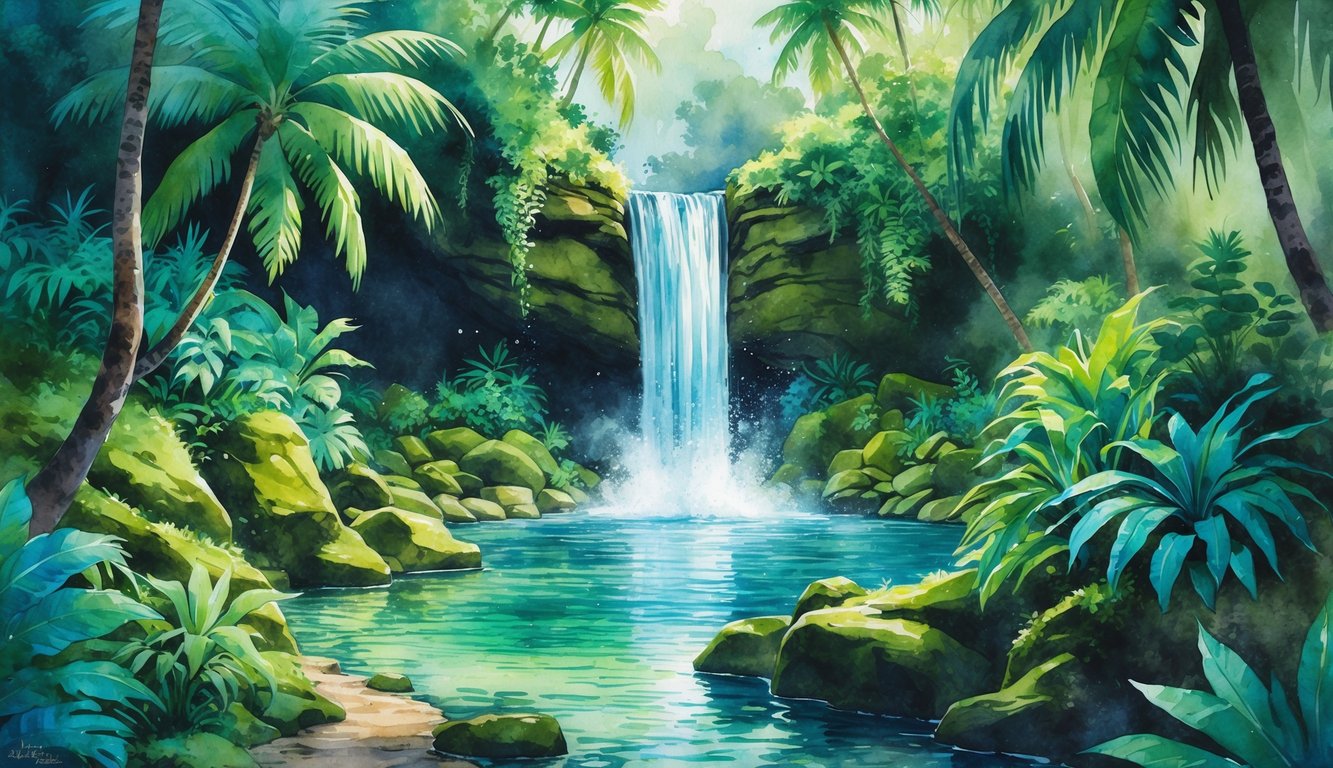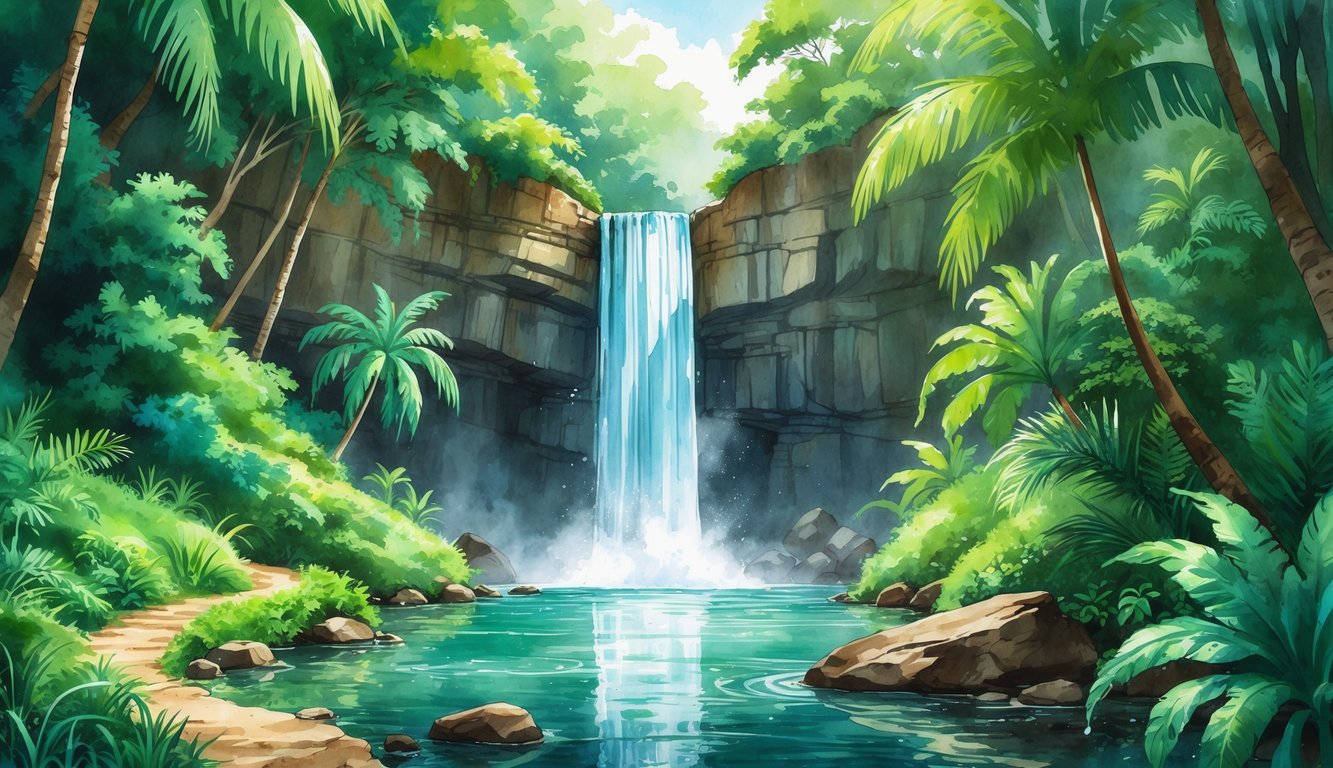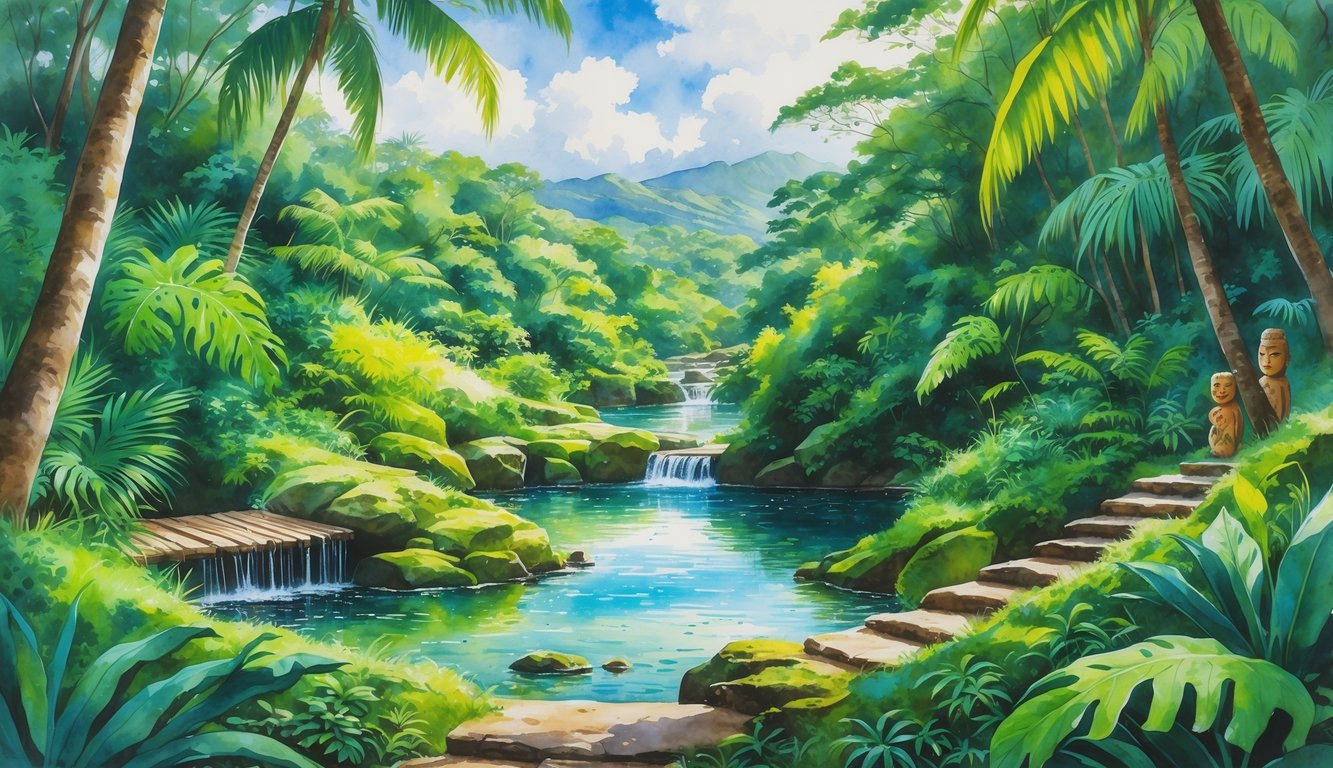Oahu’s lush valleys and forested ridges hide waterfalls that many visitors miss. These spots reveal a quieter side of the island, far from busy beaches and crowded lookouts.

Exploring Oahu’s hidden waterfalls lets travelers experience the island’s natural beauty in a peaceful setting.

Each trail, from short walks to longer treks, leads to a unique cascade. Some waterfalls have clear pools for cooling off, while others are surrounded by dense tropical plants.
Guides like the Island Hopper’s guide to Oahu’s secret waterfall hikes offer helpful maps and tips for a safe trip.
Hikers spot native plants, hear local birds, and learn about the cultural history of these landscapes. These trails connect people to Oahu’s land and traditions.
Discovering Oahu’s Hidden Waterfalls
Waterfalls on Oahu often hide in valleys, behind thick vegetation, and along less-traveled trails. Many of these spots offer quiet surroundings and cooler air from the mist.
Hikers also get a closer look at Oahu’s native plants and wildlife.
What Makes a Waterfall Hidden on Oahu?
A “hidden” waterfall usually sits away from popular tourist routes. Hikers often reach these falls by walking through forest trails, crossing streams, or following unmarked paths.
Thick foliage can shield some waterfalls, making them hard to spot until hikers get close. Others are on private land and require a guided tour or permission.
Likeke Falls is accessible by a short, less-known trail. Maunawili Falls sits deep in a lush valley.
Trails to these waterfalls often begin in residential areas or small roadside pull-offs. Busy park entrances rarely mark the start.
Because fewer people visit these waterfalls, they often stay cleaner and less disturbed. Nature lovers find these spots appealing.
Why Explore Off-the-Beaten-Path Trails?
Less-traveled waterfall hikes let visitors enjoy Oahu’s scenery without crowds. The quiet makes it easier to hear the water and spot wildlife.
These trails often lead to pools where hikers can swim or rest on shaded rocks. The Oahu Hidden Waterfall Hike offers a short, guided walk to a 35-foot cascade and a calm swimming area.
Exploring lesser-known trails supports local guides and small tour companies. Many guides share insights into Hawaiian history and native plants.
These trails can be challenging due to uneven ground or unclear markings. Hikers need to prepare for muddy paths, stream crossings, and limited facilities.
Essential Tips for Responsible Exploration
Visitors should stay on marked paths to protect fragile plants and prevent erosion. If the trail is unmarked, hiking with a guide is safest.
Pack light but bring water, snacks, insect repellent, and sturdy shoes. Use waterproof bags to protect electronics during stream crossings.
Follow leave no trace principles:
- Carry out all trash.
- Avoid picking plants.
- Don’t carve or mark rocks or trees.
Some hidden waterfalls are on private property. Always check access rules before visiting.
Websites like Island Hopper’s Guide to Oahu’s Secret Waterfall Hikes offer maps and information on permitted trails.
Respecting the environment and local rules keeps these hidden spots open for future visitors.
Top Hidden Waterfall Hikes on Oahu
Oahu features several waterfall hikes with lush rainforest scenery, natural swimming spots, and peaceful trails. Some require short walks, while others involve longer treks with steep or muddy sections.
Good footwear and water are important for most hikes.
Manoa Falls: Lush Rainforest Adventure
Manoa Falls sits in a green valley just 20 minutes from Honolulu. The trail is about 1.6 miles round trip with a gentle incline.
The path winds through bamboo groves and tropical plants. Rain often makes the trail muddy and slippery.
The waterfall drops about 150 feet into a small pool. Swimming is not recommended due to possible debris and bacteria.
Visitors sometimes combine this hike with a visit to the nearby Lyon Arboretum. Parking is available at the trailhead for a small fee.
Early morning visits help avoid crowds. More details are in the Oahu waterfall hiking guide.
Waiakeakua Falls: Secluded Jungle Gem
Waiakeakua Falls is a lesser-known spot in Manoa Valley. The hike is longer than Manoa Falls and includes stream crossings and narrow paths.
The route passes through thick rainforest with mossy rocks and tree roots. Slippery sections are common, especially after rain.
The falls have multiple tiers, with the main cascade dropping into a shallow pool. This area feels remote, and visitors rarely encounter large groups.
There is no official parking lot, so hikers often park along residential streets and use unmarked trail access points. A GPS map or navigation skills help on this hike.
The Island Hopper’s guide provides directions.
Waimano Falls: Multi-Tiered Pools
Waimano Falls features natural pools and rope swings. The trail is about 3 miles round trip and starts at the end of Waimano Home Road in Pearl City.
The hike descends through a forested ridge before dropping steeply toward the falls. The return trip is uphill and can be tiring.
At the base, several pools connect by small cascades. Some visitors swim or jump from the rocks, but water levels and currents can change, so caution is important.
Parts of the trail have limited shade, so hikers should bring water and prepare for a warm climb back. More information is in the best Oahu waterfall hikes list.
Maunawili Falls: Tropical Escape
Maunawili Falls is a popular hike on Oahu’s windward side. The trail is about 3 miles round trip and is often muddy due to frequent rain.
The route passes through guava trees, ferns, and stream crossings. Hikers should expect wet shoes by the end.
The waterfall is about 20 feet high and flows into a deep pool. Many visitors swim here, and some jump from the rocks, but always check conditions first.
Parking is limited, and local rules may restrict access at times. The Island Life Hawaii waterfall guide gives more details.
Planning Your Waterfall Hiking Adventure

Visitors can make the most of Oahu’s waterfall hikes by choosing the right season, bringing essential gear, and knowing trail access rules. Weather, trail safety, and preparation all matter for a smooth hike.
Best Times to Visit Oahu’s Waterfalls
Water levels and trail conditions change with the seasons. The wetter months from November to March bring stronger flows and more dramatic waterfalls.
Heavy rain can also make paths slippery or cause closures. The drier months from April to October usually have safer footing and clearer skies.
Some falls may have lighter flow during dry months, but trails are easier to navigate. Weekdays are less crowded than weekends.
Arrive early to enjoy places like Likeke Falls or Manoa Falls before groups arrive. Check the daily weather forecast because sudden showers and flash floods can happen.
What to Pack for a Safe Hike
Wear lightweight, moisture-wicking clothing for Oahu’s humid climate. Sturdy hiking shoes with good grip are essential for wet or uneven trails.
A small backpack holds water, snacks, sunscreen, and insect repellent. Pack a light rain jacket, even in the dry season.
For safety, bring:
- First aid kit
- Fully charged phone (with offline maps)
- Headlamp or flashlight
- Reusable water bottle or hydration pack
Waterproof bags protect electronics and valuables near the falls.
Understanding Trail Access and Permits
Not all waterfall hikes on Oahu are open to the public. Some, especially those on private land, need permission or a guided tour.
Certain hidden waterfall hikes are only accessible through local operators. State-managed trails like Manoa Falls or Waimea Valley may charge entrance fees.
These fees help maintain trails and facilities. Always respect posted signs and avoid trespassing.
Some areas are protected for cultural or environmental reasons. Parking rules vary by location, and some spots require paid parking or timed entry.
Planning ahead helps avoid delays.
Nature and Culture Along the Trails

Hikers in Oahu often see lush landscapes, rare plants, and signs of deep cultural history. Trails can pass through areas that are both ecologically sensitive and culturally important.
Awareness and respect are essential.
Spotting Native Hawaiian Flora
Oahu’s rainforest and valley trails feature plants found only in Hawaii. Hikers may see the ʻōhiʻa lehua tree with bright red or yellow blossoms.
This tree is a key part of the native ecosystem. Other common plants include hapuʻu tree ferns, koa trees, and native hibiscus.
These species provide food and shelter for wildlife and help prevent erosion on steep slopes.
Some trails, especially those to hidden waterfalls, pass through areas where invasive plants compete with native species. Volunteers work to remove these invaders and restore native growth.
A small plant guide or plant ID app helps hikers recognize what they see. Staying on marked paths protects fragile roots and rare plants.
Respecting Local Traditions and Land
Many waterfall trails cross lands with cultural and historical significance. Some sites sit near ancient Hawaiian agricultural terraces, heiau (temples), or burial grounds.
Please follow posted signs and avoid disturbing any stones, structures, or artifacts. In Hawaiian culture, these places are part of a living heritage.
Local hiking groups and tours, such as those from Aloha Ascents, often share stories about the land’s meaning. Listening to these guides can help you understand and appreciate the area.
Show respect for the land and local community by packing out all trash. Avoid loud noise and do not pick plants.
Wildlife and Natural Beauty to Observe
Hikers may spot native birds like the apapane or amakihi. These birds feed on nectar from native flowers.
Birdwatchers often find early mornings are the best time to see these species.
Streams and pools near waterfalls sometimes hold native fish or freshwater shrimp. Watching them without touching or feeding helps protect the ecosystem.
Some trails provide views of ridgelines and valleys. Hikers can also see ocean vistas along the same hike.
On clear days, the green forest and blue coastline create a beautiful contrast. This scenery makes Oahu’s nature stand out.
Using binoculars or a camera helps capture these moments. This way, you avoid disturbing the wildlife or environment.




